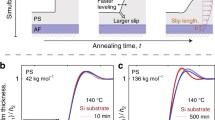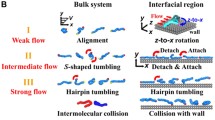Abstract
The low shear rate interfacial slip behaviors of nonentangled bead–spring polymer melts are firstly simulated using a multiscale method without constitutive relations and wall slip hypotheses. Two orders of magnitude less computation compared with pure molecular dynamics simulations offers the present multiscale method unique capability to resolve the low shear rate slip problems for complex fluids, and to explore the impacts of bulk viscosity and interfacial friction coefficient on slip phenomenon detailedly. Variation of wall–fluid interaction (WFI) can lead to completely opposite trends of rate-dependent slip. For weak WFI, two distinct slip regimes including rate-independent regime and rapid increase regime can be found due to the competition between bulk viscosity and interfacial friction coefficient. For moderate WFI, the complete dominance of the bulk viscosity leads to a linear relation between the slip length and the bulk viscosity and two distinct regimes composed of rate-independent regime and rapid decrease regime.










Similar content being viewed by others
References
Bao L, Priezjev NV, Hu H, Luo K (2017) Effects of viscous heating and wall-fluid interaction energy on rate-dependent slip behavior of simple fluids. Phys Rev E 96(3):033110
Barraud C, Cross B, Picard C, Restagno F, Léger L, Charlaix E (2019) Large slippage and depletion layer at the polyelectrolyte/solid interface. Soft Matter 15(31):6308–6317
Bocquet L, Barrat JL (2007) Flow boundary conditions from nano-to micro-scales. Soft Matter 3(6):685–693
Cao BY, Chen M, Guo ZY (2006) Effect of surface roughness on gas flow in microchannels by molecular dynamics simulation. Int J Eng Sci 44(13–14):927–937
Cosden IA, Lukes JR (2013) A hybrid atomistic-continuum model for fluid flow using lammps and openfoam. Comput Phys Commun 184(8):1958–1965
De S (2013) Computational study of the propagation of the longitudinal velocity in a polymer melt contained within a cylinder using a scale-bridging method. Phys Rev E 88(5):052311
De S, Fish J, Shephard MS, Keblinski P, Kumar SK (2006) Multiscale modeling of polymer rheology. Physi Rev E 74(3):030801
Drikakis D, Asproulis N, Shapiro E, Benke M (2010) Computational strategies for micro-and nanofluid dynamics. Microfluid Dev Nanotechnol Fund Concepts 4:97–153
Evans DJ, Morriss G (1984) Nonlinear-response theory for steady planar couette flow. Phys Rev A 30(3):1528
Grest GS, Kremer K (1986) Molecular dynamics simulation for polymers in the presence of a heat bath. Phys Rev A 33(5):3628
Hénot M, Grzelka M, Zhang J, Mariot S, Antoniuk I, Drockenmuller E, Léger L, Restagno F (2018) Temperature-controlled slip of polymer melts on ideal substrates. Phys Rev Lett 121(17):177802
Hsu H, Patankar N (2010) A continuum approach to reproduce molecular-scale slip behaviour. J Fluid Mech 645:59
Irving J, Kirkwood JG (1950) The statistical mechanical theory of transport processes. iv. the equations of hydrodynamics. J chem Phys 18(6):817–829
Jabbarzadeh A, Atkinson J, Tanner R (2000) Effect of the wall roughness on slip and rheological properties of hexadecane in molecular dynamics simulation of couette shear flow between two sinusoidal walls. Physi Rev E 61(1):690
Kremer K, Grest GS (1990) Dynamics of entangled linear polymer melts: a molecular-dynamics simulation. J Chem Phys 92(8):5057–5086
Kröger M, Hess S (2000) Rheological evidence for a dynamical crossover in polymer melts via nonequilibrium molecular dynamics. Phys Rev Lett 85(5):1128
Larson RG, Desai PS (2015) Modeling the rheology of polymer melts and solutions. Annu Rev Fluid Mech 47:47–65
Lees A, Edwards S (1972) The computer study of transport processes under extreme conditions. J Phys C Solid State Phys 5(15):1921
Lichter S, Martini A, Snurr RQ, Wang Q (2007) Liquid slip in nanoscale channels as a rate process. Phys Rev Lett 98(22):226001
Lockerby DA, Duque-Daza CA, Borg MK, Reese JM (2013) Time-step coupling for hybrid simulations of multiscale flows. J Comput Phys 237:344–365
Malkin AY, Patlazhan S (2018) Wall slip for complex liquids-phenomenon and its causes. Adv Coll Interface Sci 257:42–57
Martini A, Hsu HY, Patankar NA, Lichter S (2008a) Slip at high shear rates. Phys Rev Lett 100(20):206001
Martini A, Roxin A, Snurr RQ, Wang Q, Lichter S (2008b) Molecular mechanisms of liquid slip. J Fluid Mech 600:257–269
Niavarani A, Priezjev NV (2008a) Rheological study of polymer flow past rough surfaces with slip boundary conditions. J Chem Phys 129(14):144902
Niavarani A, Priezjev NV (2008b) Slip boundary conditions for shear flow of polymer melts past atomically flat surfaces. Phys Rev E 77(4):041606
O’connell ST, Thompson PA (1995) Molecular dynamics-continuum hybrid computations: a tool for studying complex fluid flows. Phys Rev E 52(6):R5792
Priezjev NV (2009) Shear rate threshold for the boundary slip in dense polymer films. Phys Rev E 80(3):031608
Priezjev NV, Troian SM (2004) Molecular origin and dynamic behavior of slip in sheared polymer films. Phys Rev Lett 92(1):018302
Pye JE, Wood CE, Burton JC (2018) Precursors to molecular slip on smooth hydrophobic surfaces. Phys Rev Lett 121(13):134501
Robbins M (1997) All stressed out. Nature 389(6649):331–333
Servantie J, Müller M (2008) Temperature dependence of the slip length in polymer melts at attractive surfaces. Phys Rev Lett 101(2):026101
Sochi T (2011) Slip at fluid-solid interface. Polym Rev 51(4):309–340
Sparreboom W, van den Berg A, Eijkel JC (2009) Principles and applications of nanofluidic transport. Nat Nanotechnol 4(11):713
Sun J, Wang W, Wang HS (2013) Dependence of nanoconfined liquid behavior on boundary and bulk factors. Phys Rev E 87(2):023020
Sun J, Wang W, Wang HS (2015) Viscous dissipation effect in nano-confined shear flows: a comparative study between molecular dynamics and multi-scale hybrid simulations. Microfluid Nanofluid 18(1):103–109
Thompson PA, Troian SM (1997) A general boundary condition for liquid flow at solid surfaces. Nature 389(6649):360–362
Tong ZX, He YL, Tao WQ (2019) A review of current progress in multiscale simulations for fluid flow and heat transfer problems: the frameworks, coupling techniques and future perspectives. Int J Heat Mass Transfer 137:1263–1289
Yang J, Wan Z, Wang L, Sun D (2018) A study on slip characteristics using hybrid particle-continuum method. J Fluids Eng 140(10)
Yasuda S, Yamamoto R (2010) Multiscale modeling and simulation for polymer melt flows between parallel plates. Phys Rev E 81(3):036308
Yasuda S, Yamamoto R (2011) Dynamic rheology of a supercooled polymer melt in nonuniform oscillating flows between rapidly oscillating plates. Phys Rev E 84(3):031501
Yasuda S, Yamamoto R (2014) Synchronized molecular-dynamics simulation via macroscopic heat and momentum transfer: an application to polymer lubrication. Phys Rev X 4(4):041011
Yong X, Zhang LT (2013a) Slip in nanoscale shear flow: mechanisms of interfacial friction. Microfluid Nanofluid 14(1–2):299–308
Yong X, Zhang LT (2013b) Thermostats and thermostat strategies for molecular dynamics simulations of nanofluidics. J Chem Phys 138(8):084503
Acknowledgements
We gratefully acknowledge support of this work by the National Natural Science Foundation of China (U1730124,11972338,11621202), and the Fundamental Research Funds for the Central Universities. The numerical calculations in this paper have been done on the supercomputing system in the Supercomputing Center of the University of Science and Technology of China. The authors thank Prof. Dr. Nikolai V. Priezjev of the Wright State University for helpful discussions.
Author information
Authors and Affiliations
Corresponding authors
Ethics declarations
Conflict of interest
The authors declare that they have no conflict of interest.
Additional information
Publisher's Note
Springer Nature remains neutral with regard to jurisdictional claims in published maps and institutional affiliations.
Rights and permissions
About this article
Cite this article
Yan, H.J., Qin, F.H., Wan, Z.H. et al. Multiscale simulations of interfacial slip for polymer melts under shear flow. Microfluid Nanofluid 25, 9 (2021). https://doi.org/10.1007/s10404-020-02407-6
Received:
Accepted:
Published:
DOI: https://doi.org/10.1007/s10404-020-02407-6




